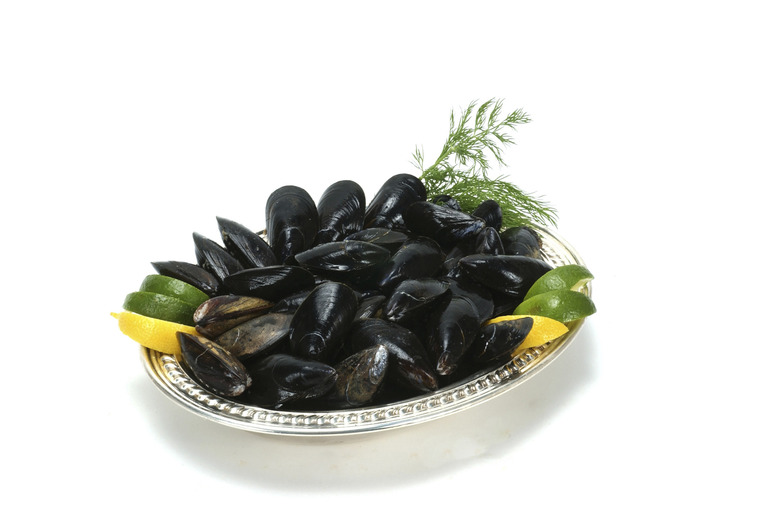How To Tell The Age Of A Clam
Ever hear the expression, "Happy as a clam?" That's because not only do clams and other bivalves have limited neurological function, but many have extended lifespans. The oldest known clam, an Arctica islandica, was found in 2007 off the coast of Iceland. The 507-year-old clam was named "Ming" after the Chinese dynasty in power when it was born. Geoducks, another common bivalve, also have long lifespans within the animal kingdom, usually living up to 140 years.
How do scientists determine the age of a clam? Just like counting the rings of a tree, you can count the rings on a clam. Darker rings are created in fall and winter, possibly because of colder water and changes in food abundance. Growth of shells considerably slows as the clam gets older. You can see this when you compare the distance of one ring to another from the center of the shell to the edge of the shell.
How Do Clams Grow Shells?
How Do Clams Grow Shells?
To grow a shell, a part of the shellfish called the mantle secretes fluid that contains calcium, carbon, and oxygen. Carbon and oxygen are found together as calcium carbonate. First, a layer of conchiolin (protein and chitin) is formed, and then the mantle builds another layer of calcium carbonate shell, composed of either calcite or the mineral aragonite.
Finding a Clam Shell
Finding a Clam Shell
To count rings on a clam, you can visit a beach and usually find a variety of abandoned shells. If you don't live by a beach, you might be able to obtain shells from a seafood company.
You must always consult with and abide by state laws when harvesting clams. Common clam shells you may come across on the beach include: littlenecks, middlenecks, chowders, steamers and manilas. These clams typically do not dig fast.
Razor clams, however, are fast diggers and have an elongated shape. Using a "clam tube" (also called a clam gun) on the beach, you can watch for the tell-tale burrowing of a razor clam in the sand. This includes mounds with small dimples at the top. By stomping lightly on the sand, you can get the clam to move or make these mounds. Immediately, place the clam tube over the mound and wiggle it down in the sand. You must be quick, as razor clams are fast diggers. When you pull up the tube, hopefully, the razor clam will be sand that comes out of the tube.
Once you have secured a razor clam, counting the rings will be a little different than hard-shelled clams. Razor clam shells are smooth and do not have ridges. They still have darker rings, and this is what you count in order to figure out their age.
Variety of Shells
Variety of Shells
Why do molluscs have such a wide variety of shells? As a shell grows bigger, more layers form. These layers can be affected by temperature, tidal changes and water composition (pH or heavy metals, for example); shells record the world around them. The color and stripes can be due to difference in food sources. The smoothness of a shell can be a product of tidal action or the substrate at a beach, such as sand, gravel or rock.
There are small clams like the button clam, which are under 1 7/8 inches long. Giant clams, which live in the Indian and southern Pacific Oceans, are enormous and can weigh more than 440 pounds. Geoducks and horse clams also have huge shells, up to 8 inches long. With the siphon, a geoduck clam can be 3.3 feet long. A clam siphon is what is responsible for squirting water into the air and acts like a big long nose hunting for prey.
Clams are truly amazing creatures; They clean our water through filtration, make beautiful protective homes and function as a food source for billions of people. Very rarely, they may also make a pearl, like oysters can, so start your search today to count the rings. You never know what treasure you will find inside a clam.
References
- Science Daily: Longest Living Animal?
- University of California Museum of Paleontology: The Bivalvia
- Alaska Pacific University: Estimating Age and Shell Growth Rates in Pacific Razor Clams
- Australian Academy of Science: She Sells Sea Shells...
- CBS: Ming the Clam, World's Oldest Animal, Was Actually 507 Years Old
Cite This Article
MLA
Medlen, Sasha. "How To Tell The Age Of A Clam" sciencing.com, https://www.sciencing.com/tell-age-clam-8726823/. 24 June 2019.
APA
Medlen, Sasha. (2019, June 24). How To Tell The Age Of A Clam. sciencing.com. Retrieved from https://www.sciencing.com/tell-age-clam-8726823/
Chicago
Medlen, Sasha. How To Tell The Age Of A Clam last modified March 24, 2022. https://www.sciencing.com/tell-age-clam-8726823/
